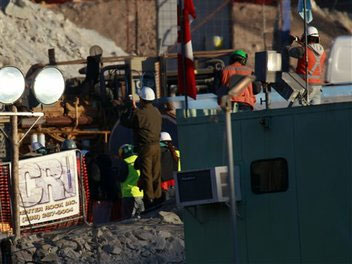
|  |  |  Americas & Beyond Americas & Beyond  
A Way Out, at Last, for Chile's 33 Trapped Miners
 Michael Warren - Associated Press Michael Warren - Associated Press
go to original
October 09, 2010


| | Workers involved in the operations to rescue 33 trapped miners are seen taking pictures in the San Jose Mine near Copiapo, Chile Saturday, Oct. 9, 2010. (AP/Dario Lopez-Mills) |  |
San Jose Mine, Chile — Sixty-six agonizing days after their gold and copper mine collapsed above them, 33 miners were offered a way out Saturday as a drill broke through to their underground purgatory.

Word of the drill's success prompted cheers, tears and the ringing of bells by families in the tent camp outside the mine. Some who have kept a vigil since the Aug. 5 disaster ran up a hill where 33 Chilean flags were planted, chanting and shouting with joy as a siren rang throughout "Camp Hope," confirming the breakthrough.

The "Plan B" drill won a three-way race against two other drills to carve a hole wide enough for an escape capsule to pull the miners out one by one.

While "Plan A" and "Plan C" stalled after repeatedly veering off course, the "Plan B" drill reached the miners at a point 2,047 feet (624 meters) below the surface after pushing through the final 128 feet (39 meters) overnight.

The milestone thrilled Chileans, who have come to see the rescue drama as a test of the nation's character and pride, and eased some anxiety among the miners' families.

But now comes a difficult judgment call: The rescue team must decide whether it's more risky to pull the miners through unreinforced rock, or to insert tons of heavy steel pipe into the curved shaft to protect the miners on their way up.

President Sebastian Pinera reminded Chileans Friday that he had promised "to do everything humanly possible" to keep the miners safe.

Steel pipe would prevent stones from falling and potentially jamming the capsule, but it wouldn't save a miner if the unstable mine suffers another major collapse, and might itself provoke a disastrous setback, Mining Minister Laurence Golborne said.

"You would have to put though a 600-meter hole a lot of pipes that weigh more than 150 tons," he warned. "And this structure can be set in a position that also could block the movement of the Phoenix (escape capsule). It's not an decision easy to make."

If Saturday's close video examination persuades engineers that the shaft is smooth, strong and uniform enough to let the capsule pass without significant obstacles, then rescuers plan to start pulling the men out one by one as early as Tuesday, in a made-for-TV spectacle that has captivated the world.

The miners will be initially examined at a field hospital where they can briefly reunited with up to three close relatives. Then, they'll be flown by helicopter in small groups to the regional hospital in Copiapo, were a wing of 33 fresh beds await to care for them for no fewer than 48 hours. Only after their physical and mental health is thoroughly examined will they be allowed to go home.

Associated Press writers Vivian Sequera at the mine and Eva Vergara in Copiapo, Chile, contributed to this story.
|

 |
|  |



